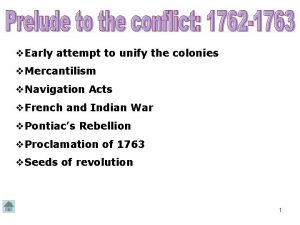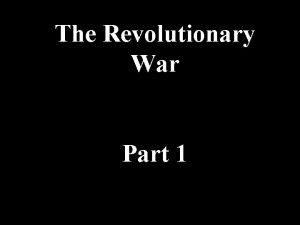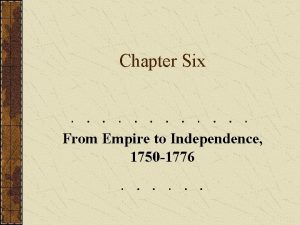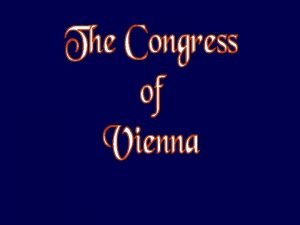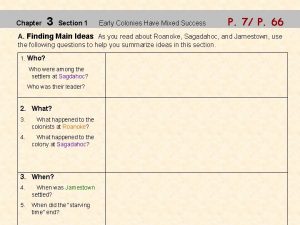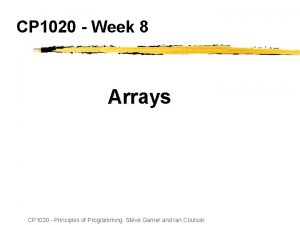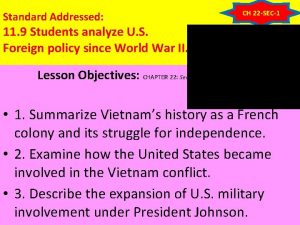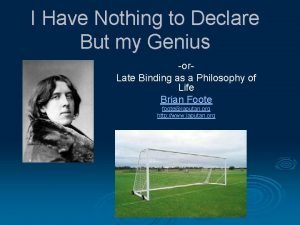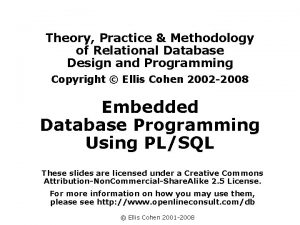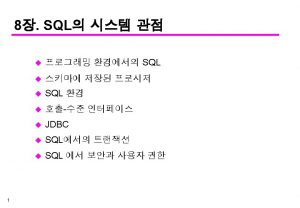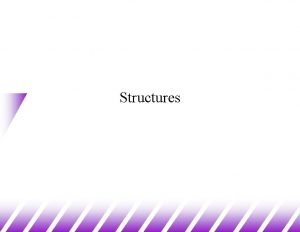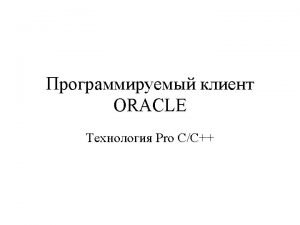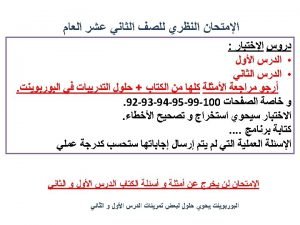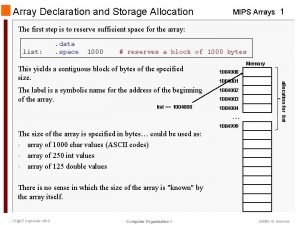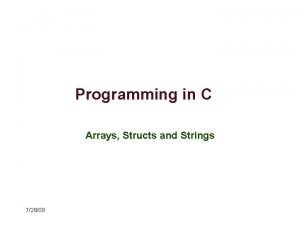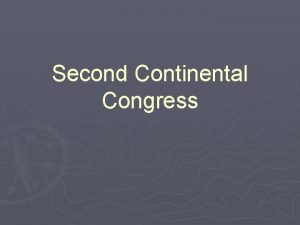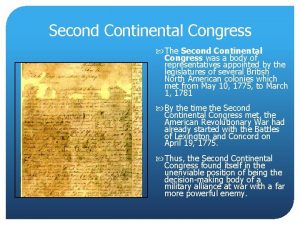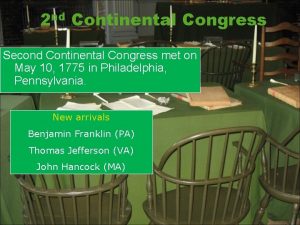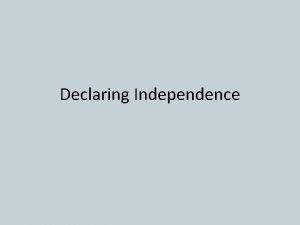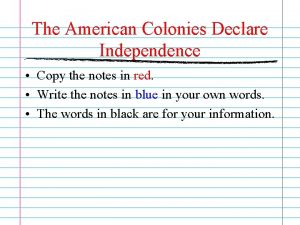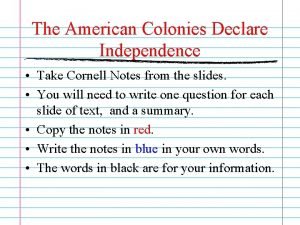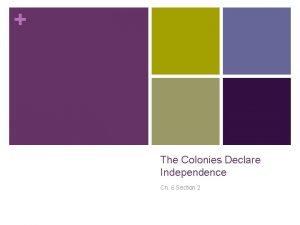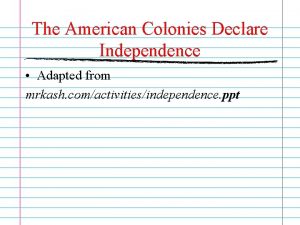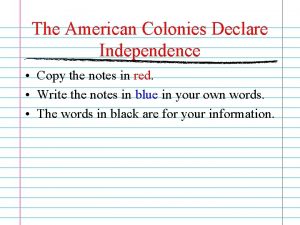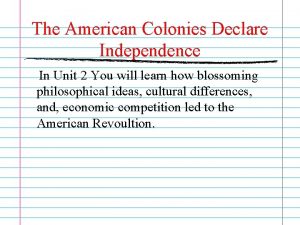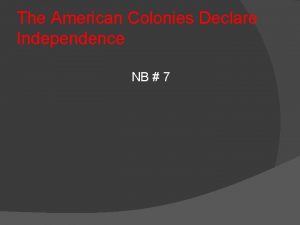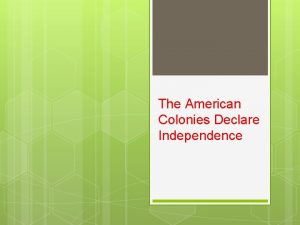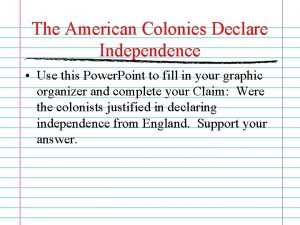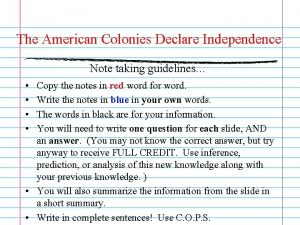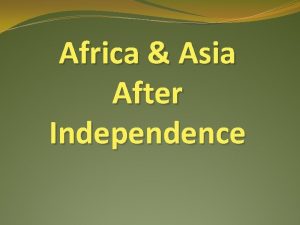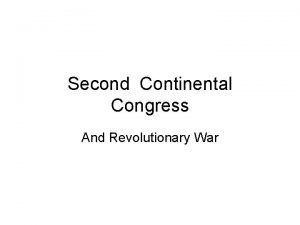The Colonies Declare Independence The Continental Congress After
























- Slides: 24

The Colonies Declare Independence

The Continental Congress • After the passing of the Coercive (Intolerable) Acts, the 13 colonies were fed up with England, King George, and Parliament. • Colonial leaders met in Philadelphia to discuss their opposition to British policy. • They called themselves the Continental congress

The Continental Congress • The First Continental Congress met in Philadelphia in September of 1774. • There were 55 delegates from each colony EXCEPT Georgia • The delegates were meeting to set up a body to represent American interests and challenge British control of the colonies

The Continental Congress • Many famous colonial leaders attended this meeting…this includes − John and Samuel Adams (Massachusetts) − John Jay (New York) − Patrick Henry, Richard Henry Lee, and George Washington (Virginia) • These leaders all agreed that the time had come for the Colonies to take a stand against England

The Continental Congress • The Continental Congress decided to: − Created a list of complaints against England − Voted to boycott British trade − Authorized the forming of militias • Groups of citizen soldiers who are armed and trained to fight

The Fighting Begins • England King George were not happy about this Continental Congress. • They knew they were going to have to stomp out this rebellion quickly. • The Colonists knew that if fighting with the English was going to begin, it would begin in the New England Colonies. • Militia companies in New England began training.

The Fighting Begins • They had a special group of fighters that were called Minutemen. − Minutemen were militia members who could be called to fight at a moments notice. • King George knew the colonists were serious. He already had several thousand troops in and around Boston and ordered more troops to leave England for the colonies.

The Fighting Begins • King George ordered Thomas Gage, the British General in Boston to take away all weapons of the Boston militia and arrest the leaders. • General Gage knew that the colonial militia was storing weapons at an arsenal in Concord. He decided to send his troops their to seize the weapons. • The colonists knew the British were ready to attack, and they came up with a plan.

The Fighting Begins • What the colonists did not know was if the British would attack by land or by sea, and they needed to prepare for either situation. • The colonists assigned volunteers to observe and report the movement of the British. It was decided that a lantern and an old church would be used as a signal. • If the British were to attack by land, one lantern would be hung in the church steeple.

The Fighting Begins • If the British were to attack by sea, two lanterns would be hung in the church steeple. • Paul Revere, a devoted member of the Sons of Liberty was chosen as the person who would warn others of a British attack. • The British finally began to move on the night of April 18, 1775

The Fighting Begins • The Midnight Ride of Paul Revere: − Paul Revere and Andre Dawes were to ride on horseback to Lexington to warn John Hancock and Samuel Adams about the British movement. • The stage was set for the first battle at Lexington

The Fighting Begins • Lexington: − Colonial militia were waiting on the British in the town square − When the British approached, the minutemen fired. − This is called “The Shot Heard Around the World − British troops were able to move past the militia

The Fighting Begins • Concord: the British now were moving toward Concord − The colonial militia had already moved the weapons • They were waiting for the British at the Old North Bridge in Concord − Fighting broke at the Bridge. The militia were able to force the British troops to retreat and head back to Boston • The colonists needed more weapons and set their sites on Fort Ticonderoga.

The Fighting Begins • Fort Ticonderoga: May 10, 1775 − British fort holding weapons/ ammunition − Benedict Arnold was told to attack the fort for the colonies and get the weapons − Ethan Allen and his Green Mountain Boys were also going to attack the fort. − The two groups joined together and surprise attacked the British at the fort, forcing them to surrender.

The Fighting Begins • Bunker Hill: June 16, 1775 • Bunker Hill and Breeds Hill overlooked Boston • The British wanted these hills for their strategic value • The British decided to attack. They had way more troops and ammunition than the militia. • The militia leader, William Prescott knew this and came up with a plan

The Fighting Begins • Bunker Hill: June 16, 1775 − Knowing the British were going to charge the hill, Prescott told his men not to fire until they could see the white of the British soldiers eyes. − This worked…the militia was able to fight the British off three different times. − The Americans eventually ran out of gun powder and had to withdraw. − Even though the British won the land it was a victory for the Americans because it showed the British they could fight and would not give up easily.

Choosing Sides • Now that fighting had started between Britain and the Colonies, people in the colonies had to choose sides: − Loyalist: supported Britain and King George − Patriot: supported the colonies and independence

Moving Towards Independence • The Second Continental Congress: − Began on May 10 1775 in Philadelphia − All 13 colonies sent representatives − Many influential leaders: • All of the delegates from the first Congress returned • Benjamin Franklin (Pennsylvania) • John Hancock (Massachusetts) served as President of the Congress • Thomas Jefferson (Virginia) − This group began to govern the colonies

Moving Towards Independence • The Second Continental Congress: − Authorized the printing of colonial money − Set up a colonial post office − Established the Continental Army with George Washington as the General • Olive Branch Petition: − Issued by Congress to King George − Offered peace if he would protect the Colonists rights

Moving Towards Independence • Declaring Independence: • The issue now facing the colonies was whether or not to break all ties with England. • Richard Henry Lee of Virginia was the first delegate to purpose independence. • Congress formed a committee to draft a Declaration of Independence:

Moving Towards Independence • Congress formed a committee to draft a Declaration of Independence: − Thomas Jefferson, Benjamin Franklin, and John Adams were the major committee members − They worked to draft ideas for the Declaration. − Thomas Jefferson wrote the final draft • Congress finally voted on the issue of independence on July 2, 1776

The Declaration: • There were 4 parts to the Declaration of Independence −July 4 th, 1776

The Declaration of Independence • There were four parts of the Declaration: − Preamble: • Introduction • Explains why the Congress is declaring its independence − Natural Rights • Lists the God given rights of “man” − List of Grievances against England • Explains how the colonies thing England has done them wrong

The Declaration of Independence • There were four parts of the Declaration: − Resolution (Proclamation) of Independence: • States that the colonies are now a free and independent nation −
 What did ho chi minh declare after japan was forced out
What did ho chi minh declare after japan was forced out Convergent vs divergent boundaries
Convergent vs divergent boundaries Convergent plate boundary
Convergent plate boundary First continental congress
First continental congress What was the goal of the first continental congress?
What was the goal of the first continental congress? First continental congress convenes
First continental congress convenes First continental congress definition
First continental congress definition The first continental congress
The first continental congress After me after me after me
After me after me after me If any man comes after me
If any man comes after me Congress of vienna map before and after
Congress of vienna map before and after How did the english finance their colonies after 1606?
How did the english finance their colonies after 1606? Declare a two dimensional array of strings named chessboard
Declare a two dimensional array of strings named chessboard What did the vietminh declare as its main goal?
What did the vietminh declare as its main goal? I have nothing to declare except my genius
I have nothing to declare except my genius Declare deptrec is record
Declare deptrec is record Exec sql begin declare section
Exec sql begin declare section I have nothing to declare but my genius
I have nothing to declare but my genius Declare a struct
Declare a struct Exec sql begin declare section
Exec sql begin declare section Declare an array alpha of 15 elements of type int.
Declare an array alpha of 15 elements of type int. Mips declare array
Mips declare array Declare a struct
Declare a struct Declare plsql
Declare plsql Thể thơ truyền thống
Thể thơ truyền thống



